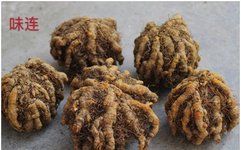Huang Lian
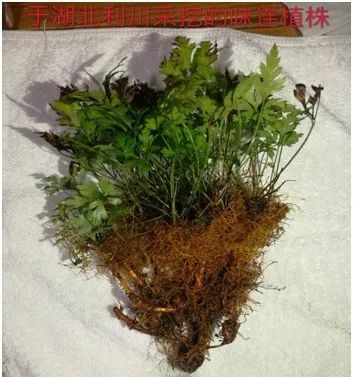
Huang Lian
Source: The dried rhizome of the perennial herbaceous plants Huang Lian (Coptis chinensis Franch.), Sanjiao Ye Huang Lian (Coptis deltoidea C. Y. Cheng et Hsiao), or Yun Lian (Coptis teeta Wall.). These three types are commonly referred to as “Wei Lian”, “Ya Lian”, and “Yun Lian” respectively.
Alias: Wang Lian, Zhi Lian, Chuan Lian, Ji Zhua Lian, etc.
Production Areas:
1. Wei Lian: Mainly produced in Shizhu, Chongqing, with additional production in Hubei, Shaanxi, and Gansu. Mostly cultivated, wild specimens are rare. It is the main source of commercial Huang Lian.
2. Ya Lian: Mainly produced in Hongya, Sichuan, and Emei, also cultivated, with very few wild specimens.
3. Yun Lian: Mainly produced in Deqin, Yunnan, Bijiang, and southeastern Tibet, originally wild, now cultivated.
Harvesting and Processing: Harvested in autumn, removing the fibrous roots and soil, then dried and cleaned of residual fibrous roots.
Identification of Characteristics:
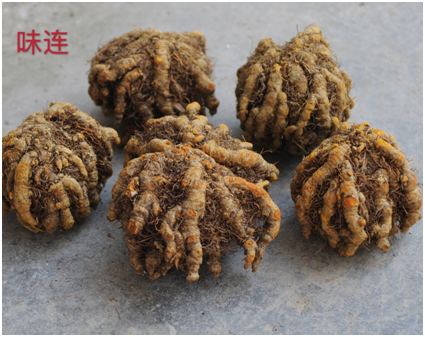
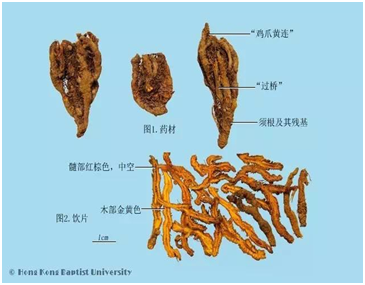
1. Wei Lian: Highly branched, often curved, clustered like chicken claws, commonly referred to as “Chicken Claw Huang Lian”. Single rhizome 3-6 cm long, diameter 0.3-0.8 cm. Surface grayish-yellow or yellow-brown, rough, with irregular nodules, fibrous roots, and remnants of fibrous roots. Some segments are long and smooth like stems, commonly referred to as “Crossing the Bridge”. The upper part often retains brown scale leaves, with remnants of stems or petioles at the top. Hard texture, uneven fracture surface, orange-red or dark brown bark, fresh yellow or orange-yellow wood, with radial arrangement of fibers, central pith red-brown, some hollow. Slight odor, extremely bitter taste.
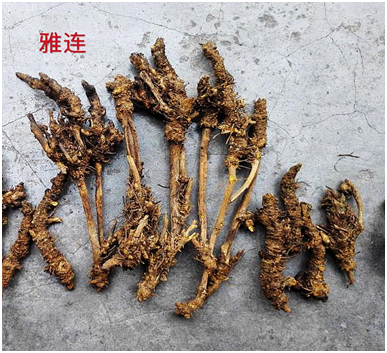
2. Ya Lian: Mostly single-stemmed, slightly cylindrical, slightly curved, 4-8 cm long, diameter 0.5-1 cm. “Crossing the Bridge” is relatively long. The top has a small amount of residual stem.
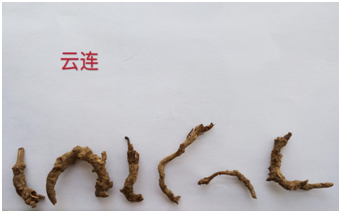
3. Yun Lian: Curved and hook-shaped, mostly single-stemmed, relatively small, resembling a scorpion’s tail. 2-5 cm long, diameter 0.2-0.4 cm. The fracture surface is relatively flat, yellow-brown.
All are best when the rhizomes are thick, solid, and bright yellow or orange-yellow.
Discussion: A Brief Discussion on the Microscopic Identification Characteristics of the Three Types of Huang Lian
Wei Lian, Ya Lian, and Yun Lian differ in appearance, as mentioned above; additionally, in previous articles of the “Cao Mu Ben Xin” series, we discussed that the identification of medicinal materials also includes microscopic identification methods. Certain features such as the presence or absence of stone cells, the morphology of calcium oxalate crystals, some special abnormal structures, and the characteristics of trichome duct fibers can all serve as beneficial supplements for identifying medicinal materials.
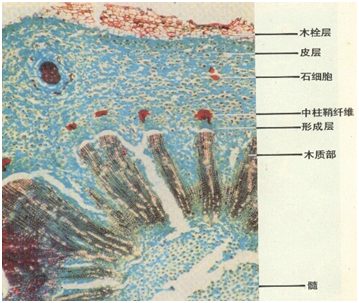
The above image shows the microscopic cross-section of Wei Lian rhizome:
It can be seen that ① The cork layer consists of several cells. ② The cortex is relatively wide, with stone cells scattered individually or in groups. ③ The central sheath fibers are bundled, sometimes accompanied by a few stone cells, all appearing yellow. ④ The vascular bundles are outerly fibrous, arranged in a ring. The cambium is not obvious. The xylem is yellow, fully lignified, and the wood fibers are well developed. ⑤ The pith consists of parenchyma cells, with no stone cells.
In Ya Lian, stone cells can be seen in the pith microscopically.
In Yun Lian, microscopic identification shows no stone cells in the cortex, central sheath, or pith.
Taste and Meridian Affinity:
Bitter, cold. Enters the Heart, Spleen, Stomach, Liver, Gallbladder, and Large Intestine meridians.
Functions:
Clears heat and dries dampness, drains fire and detoxifies.
Indications:
Huang Lian is a commonly used medicinal material in clinical practice, with a wide range of applications. The author has detailed its clinical applications to provide a comprehensive understanding of Huang Lian. “Shennong’s Herbal Classic”: “Treats heat-induced eye pain, tears from eye injuries, brightens vision, intestinal dysentery, abdominal pain, diarrhea, and swelling and pain in women’s genitalia.” “Pearl Bag”: “Drains heart fire, relieves fullness below the heart. Stir-fried with wine, soaked in wine, for use above the neck.” “Herbal Essence”: “Huang Lian is often used to treat dysentery, as it embodies the principle of bitterness and dryness. However, some use it for intestinal weakness with slight blood, without knowing when to stop, leading to danger. If the initial disease is heat with blood dysentery, it can be used to stop it without needing to use the full dose. If it is weak and cold, it should not be used.” “Herbal Compendium”: “Huang Lian resolves cold and epidemic heat, regulates the Yangming and Shaoyin channels, reduces heat in the heart and spleen, and eliminates severe diseases like dysentery with red and white stools. It is also effective for palpitations, anxiety, restlessness, and skin conditions with excess heat. Huang Lian is essential for these conditions.” In summary, it can drain all excess dampness and heat, treating heat in the heart, spleen, liver, kidney, gallbladder, stomach, and large intestine.
1. Damp-Heat Syndrome
This herb is bitter and cold, which can dry dampness and clear heat, especially effective in clearing damp-heat stagnation in the middle jiao and large intestine. It can be used to treat damp-heat obstruction syndrome, damp-heat diarrhea, and damp-heat skin toxicity.
1. Damp-Heat Obstruction Syndrome: This herb is effective in clearing spleen and stomach damp-heat. Damp-heat obstruction leads to stagnation of qi, resulting in fullness and discomfort in the abdomen, nausea, and vomiting. It is often combined with Ban Xia (Pinellia ternata) and Gan Jiang (Dried Ginger) to open the stomach and relieve fullness, such as in the “Shang Han Lun” Ban Xia Xie Xin Tang. If damp-heat is hidden, with both stomach and intestinal damp-heat, cholera with vomiting and diarrhea, it is often combined with Hou Po (Magnolia Bark), Ban Xia, and Shi Chang Pu (Acorus tatarinowii) to move qi and transform dampness, restoring balance in the stomach and intestines, such as in the “Cholera Treatise” Lian Po Yin.
2. Damp-Heat Diarrhea: This herb enters the large intestine meridian and is effective in clearing damp-heat, making it a key herb for damp-heat diarrhea, praised as “the best for treating dysentery”. For mild cases, it can be used alone; if diarrhea is accompanied by abdominal pain and urgency, it is often combined with Mu Xiang (Saussurea) to clear heat, dry dampness, move qi, relieve pain, and stop diarrhea, such as in the “Military Department’s Hand Collection” Xiang Lian Wan. If treating exterior syndrome not resolved, with external pathogens entering the interior causing diarrhea with fever, chest heat, and thirst, this herb is often combined with Ge Gen (Pueraria) and Huang Qin (Scutellaria) for simultaneous treatment of exterior and interior, achieving the effects of releasing the exterior, clearing heat, and stopping diarrhea, such as in the “Shang Han Lun” Ge Gen Huang Qin Huang Lian Tang. Huang Lian is indeed a good medicine for treating dysentery, but “it is not suitable for those with deficiency and cold.” Modern clinical studies have shown that using concentrated Xiang Lian tablets, 5 tablets each time, 3 times a day, for 7 days, has an overall effective rate of over 90% in treating acute bacterial dysentery and enteritis.
3. Damp Skin Conditions: This herb is bitter and drying, with a cold nature that clears heat. It treats dampness-induced skin conditions, often combined with She Chuang Zi (Cnidium) and Di Fu Zi (Plantago) for enhanced effects.
2. Excess Fire Syndrome
This herb is extremely bitter and cold, with a nature that clears and drains, entering the heart, liver, and stomach meridians, making it an excellent choice for clearing heat, draining fire, and detoxifying. It is particularly effective for clearing excess heat in the heart and stomach, and for conditions of excessive liver fire. It primarily clears heat from the organs, often used for conditions of excess heat in the heart and stomach, liver fire, and blood heat leading to bleeding.
1. Heart Fire Heat Syndrome: This herb excels in draining excess heat from the heart. It can be used alone or in combination based on diagnosis. For example, the Zhu Sha An Shen Wan combines this herb with Zhu Sha (Cinnabar), Dang Gui (Angelica), and Sheng Di Huang (Rehmannia) to calm the heart while nourishing blood. It treats conditions of intense heat and agitation in the heart, leading to symptoms like high fever, irritability, and even delirium, often combined with Huang Qin and Shan Zhi Zi (Gardenia) for their bitter and cold heat-clearing properties, such as in the “Wai Tai Mi Yao” Huang Lian Jie Du Tang. If treating excess heat in the heart with yin deficiency leading to insomnia and restlessness, it can be combined with Rou Gui (Cinnamon) to calm the heart and spirit, as in the “Si Ke Jian Xiao Fang” Jiao Tai Wan.
2. Stomach Fire and Liver Fire Heat Syndromes: This herb is bitter and cold, effectively clearing liver and stomach fire, making it essential for stomach fire toothaches, heat-induced vomiting, and liver fire rising. If liver qi stagnation transforms into fire, causing pain in the ribs, vomiting sour fluid, belching, and bitter mouth, it is often combined with Wu Zhu Yu (Evodia) to clear liver fire, relieve stagnation, and guide heat downward, such as in the “Dan Xi Xin Fa” Zuo Jin Wan. For stomach fire rising, symptoms include toothaches radiating to the head, facial heat, pain that prefers cold and dislikes heat, foul breath, red tongue with yellow coating, and rapid pulse, often combined with Dang Gui, Sheng Di Huang, Mu Dan Pi (Moutan), and Sheng Ma (Cimicifuga) for treatment, such as in the “Lan Shi Mi Cang” Qing Wei San. It can also be combined with Ban Xia, Zhu Ru (Bamboo Shavings), and Chen Pi (Tangerine Peel) for heat-induced vomiting; if treating thirst and excessive drinking, this herb can be combined with Tian Hua Fen (Trichosanthes) to form a paste with lotus root juice, Sheng Di juice, ginger juice, and honey, taken with warm water, as in the “Dan Xi Xin Fa” Xiao Ke Fang. Modern clinical reports indicate that Huang Lian Jie Du Decoction (Huang Lian, Huang Qin, Huang Bai, E Jiao, Sheng Di, Xuan Shen, Mai Dong) 50 ml, taken twice daily, has a total effective rate of over 70% in treating type 2 diabetes and obesity.
3. Blood Heat and Bleeding: This herb is bitter and cold, with excellent heat-clearing and detoxifying properties, effectively stopping bleeding by clearing heat. It treats blood heat leading to vomiting or nosebleeds, often combined with Huang Qin and Da Huang (Rhubarb).
3. Heat Toxicity Syndrome
This herb is bitter and cold, with strong heat-clearing and detoxifying properties, commonly used for skin conditions caused by heat toxicity, especially effective for carbuncles and boils. It treats sores, swellings, and pain, often combined with Jin Yin Hua (Honeysuckle), Huang Qin, and Lian Qiao (Forsythia) for internal use to enhance heat-clearing, detoxifying, and anti-inflammatory effects, such as in the “Wai Ke Zheng Zong” Huang Lian Jiu Ku Tang. Alternatively, this herb can be combined with Huang Bai and Jiang Huang (Turmeric) for external use as a paste, such as in the “Yi Zong Jin Jian” Huang Lian Gao. Clinical reports indicate that Huang Lian liquid (15 g Huang Lian, boiled in 500 ml water) soaked in gauze and applied to the swollen area of patients with erysipelas for 20 minutes (30-45°C), with the wet dressing extending 2 cm beyond the skin lesions, wrapped in plastic wrap, applied twice daily for 5 days, has shown a cure rate of 27 out of 30 cases, with most cured within 6-10 days.
4. Intestinal Accumulation and Roundworms
This herb is bitter and drying, capable of killing parasites and calming roundworms, with a cold nature that clears heat and drains fire. Historical texts have recorded its use for expelling intestinal parasites and calming roundworms, such as in the “Herbal Compendium” stating it “expels intestinal parasites and kills roundworms”; “Discussion on Medicinal Properties” mentions “kills children’s roundworms”. Therefore, this herb is also used to treat children’s intestinal accumulation and roundworm-induced abdominal pain, such as in the “Tai Ping Hui Min He Ji Ju Fang” Wu Ji Wan and “Shang Han Lun” Wu Mei Wan.
In clinical practice, this herb is often used in combination to treat diabetes, hypertension, chronic enteritis, viral enteritis, gastritis, anal sinusitis, chronic rhinitis, acute and chronic tonsillitis, burns, and to prevent children’s pustular diseases.
Modern Pharmacological Research:
Huang Lian mainly contains alkaloids, including berberine, coptisine, methylcoptisine, and palmatine; both Huang Lian and its berberine content exhibit significant antibacterial effects with a broad spectrum. In vitro tests show strong inhibition against Shigella, Staphylococcus, Streptococcus pneumoniae, Vibrio cholerae, Leptospira, skin fungi, and amoebas. It also has antiviral, antipyretic, anti-inflammatory properties, and enhances the body’s defense mechanisms. Its components have effects on the cardiovascular system, including antiarrhythmic, antihypertensive, inhibiting platelet aggregation, lowering blood sugar, anti-tumor, anti-hypoxia, anti-ulcer, and choleretic effects. This herb can relax vascular smooth muscle and stimulate smooth muscle in the uterus, stomach, intestines, and bladder.

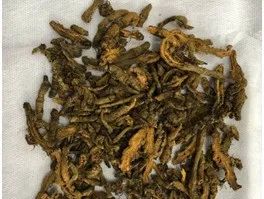
Processing Methods:
1. Huang Lian: Take the raw material, remove impurities, wash with water, soak thoroughly, slice thinly, dry, and screen out debris; or crush for use.
2. Wine Huang Lian: Take Huang Lian slices, mix with a specified amount of yellow wine, let it soak slightly, and when the wine is absorbed, place in a pot and dry over low heat, then cool and screen out debris. For every 100 kg of Huang Lian slices, use 12.5 kg of yellow wine.
3. Ginger Huang Lian: Take Huang Lian slices, mix with ginger juice, let it soak slightly, and when the ginger juice is absorbed, place in a pot and dry over low heat, then cool and screen out debris. For every 100 kg of Huang Lian slices, use 12.5 kg of fresh ginger or 4 kg of dried ginger, juiced or decocted.
4. Yu Huang Lian: Take Wu Zhu Yu (Evodia) and boil with an appropriate amount of water, remove the residue, and mix the decoction with Huang Lian slices, let it soak slightly, and when the liquid is absorbed, place in a pot and dry over low heat, then cool and screen out debris. For every 100 kg of Huang Lian slices, use 10 kg of Wu Zhu Yu.
“Introduction to Medicine”: “Huang Lian, when soaked and stir-fried with wine, ascends to the head, mouth, and tongue; when stir-fried with ginger juice, it disperses heat effectively. It treats all damp-heat conditions, epidemic heat toxins, and various toxic sores. All are treated with ginger to mitigate its cold nature, preventing heat from clashing.” “Han’s Medical Path”: “For treating primary diseases, stir-fry slightly to adapt; for excess fire, use soda; for false fire, use wine; for deficiency fire, use vinegar; for phlegm fire, use ginger juice; all should be soaked and stir-fried. For qi stagnation fire, use Wu Zhu Yu; for food accumulation and diarrhea, use yellow earth; for blood stasis and pain, use dry lacquer; all should be mixed with water and stir-fried, removing Wu Zhu Yu, earth, and lacquer. For hidden fire in the lower jiao, soak and mix with salt water.” It can be seen that historically, Huang Lian has had many processing methods, while modern methods are limited to stir-fried Huang Lian, wine Huang Lian, ginger Huang Lian, and Yu Huang Lian, which are more convenient.Huang Lian in its raw form is bitter and cold, effective in clearing heat, detoxifying, and drying dampness, while stir-frying reduces its bitter and cold properties. Ginger juice is often used to clear stomach heat and stop vomiting, while wine is used to clear upper jiao heat, and Wu Zhu Yu juice is used to disperse liver and gallbladder heat.
Processing not only involves the properties of the auxiliary materials but also the methods, temperatures, and times during processing, which can affect the internal composition of the medicinal materials.For example, in the case of wine-fried Huang Lian, the content and types of alkaloids in Huang Lian can change under different processing temperatures,indicating that if one wishes to retain the original alkaloid types in Huang Lian and increase their content, this can be achieved by controlling the processing temperature and time. Studies have shown that the antibacterial effects of processed Huang Lian products are stronger than those of raw products, with a broader antibacterial spectrum, and cocci are more sensitive to processed Huang Lian products.Processed Huang Lian products can significantly reduce acute blood sugar spikes in mice caused by high concentrations of glucose, lower serum TG and TC levels in STZ high-fat compound type 2 diabetes models, and improve glucose and lipid metabolism disorders. Thus, while all processed Huang Lian products have the effect of “stopping thirst”, those processed with Wu Zhu Yu, wine-fried, and wine-steamed show superior effects in improving insulin resistance, lowering blood sugar, and improving glucose and lipid metabolism, indicating a correlation between processing and the enhancement of the “stopping thirst” efficacy.
In summary, using Huang Lian as an example, it clearly demonstrates the significant importance of processing in the clinical efficacy of medicinal materials. The author believes that when discussing the quality of traditional Chinese medicine, processing is an important indicator that requires sufficient attention to ensure the quality of traditional Chinese medicine.
Dosage and Administration:
Internal use: Decoction, 2-5 g; or in pills or powders.
External use: Appropriate amount, ground into powder or decocted for application.
Contraindications:
This herb is extremely bitter and cold; excessive or prolonged use can easily harm the spleen and stomach, and it is contraindicated for those with spleen and stomach deficiency and cold. Bitter and drying can harm fluids, so those with yin deficiency and fluid damage should use it cautiously. (Huang Lian powder used externally or orally has occasionally caused allergic skin rashes; there have been reports of infants developing jaundice after taking Huang Lian).
Discussion: Exploring the Cultivation of Huang Lian
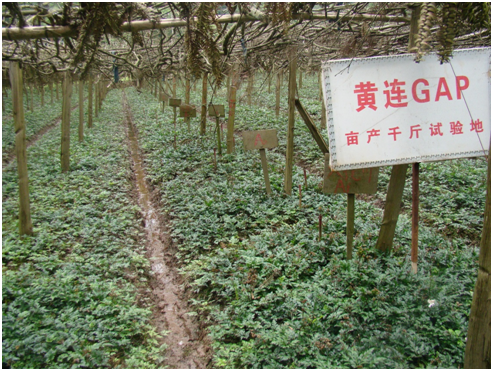
The quality of medicinal materials is determined by their cultivation. Currently, most medicinal materials are cultivated artificially, but how to cultivate them remains a significant topic. Standardized management to ensure the quality of medicinal materials, especially in clinically verifiable stable therapeutic effects, is a crucial area of focus for those in traditional Chinese medicine, warranting extensive research.
In August 2018, the author participated in the practical harvesting of Huang Lian medicinal materials in Enshi Prefecture, Hubei, at a national base for the inheritance of traditional Chinese medicine techniques. After a long journey to the fields where Huang Lian is cultivated, I observed the characteristics of the medicinal materials and listened to experts discuss the cultivation methods and GAP management models.
According to ancient herbal texts and morphological descriptions, the authentic Huang Lian used in the past was almost exclusively from the Ranunculaceae family, specifically the Coptis genus.Shizhou Huang Lian has been recorded in various herbal texts throughout history, with clear affirmations of its authenticity in the literature.Notably, Liang’s “Herbal Classic” records: “Huang Lian grows in Wuyang River Valley and Shu County, harvested in February and August,” with references to Shu County and Wuyang corresponding to present-day Sichuan, Chongqing, and western Hubei. The “New Book of Tang” geography records the local tribute lists to the court, stating, “… Shizhou: Wax, Huang Lian, medicinal fruits.” Li Shizhen’s “Compendium of Materia Medica” notes: “Huang Lian, during the Han Dynasty, was primarily sourced from Shu County, with the best being firm and heavy; during the Tang Dynasty, Li County was considered superior, and although now found in Wu and Shu, Ya County and Mei County are still regarded as excellent.” This indicates that during the Ming Dynasty, Sichuan, Hubei, Hunan, and Zhejiang remained the main production areas for Huang Lian. By the Ming and Qing Dynasties, the “Yunnan Materia Medica” introduced “Dian Lian, also known as Yun Lian, which many do not recognize, growing in Yushan,” adding Yun Lian’s production area.From this, it is evident that the distribution of Huang Lian production areas has evolved through Sichuan, Anhui, Zhejiang, Jiangxi, Hubei, and Yunnan.
The “Lichuan County Chronicle, Volume 7, Section on Products” (Ming Dynasty) records: “Huang Lian is produced in abundance in the county, resembling chicken legs.” This indicates that Huang Lian was widely cultivated in Lichuan at that time. The Qing Dynasty’s “Hongya County Chronicle” documented the cultivation methods of Huang Lian: “Currently, those who trade Huang Lian select shady mountains to cultivate wasteland, planting seedlings and covering them with bamboo and leaves to prevent sunlight, harvesting after three years.” “Huang Lian grows in wild mountains and forests, where locals use mountain seeds, creating low canopies to shield from wind and sun, requiring seven years before harvest, which is why it is bitter and cold. The shape resembles chicken claws, hence the name Chicken Claw Lian.” From the above description, it is clear that farmers were already cultivating Huang Lian according to its characteristics, selecting land, providing shade, and using soil to facilitate growth, with a cultivation period of seven years before harvesting, which aligns with modern key techniques for cultivating Huang Lian. The unique natural conditions and the wisdom and hard work of our ancestors have allowed Hubei Shizhou Huang Lian to maintain a leading position in the medicinal market, ensuring its authenticity and efficacy, thus passing down this authentic medicinal material to the present day!
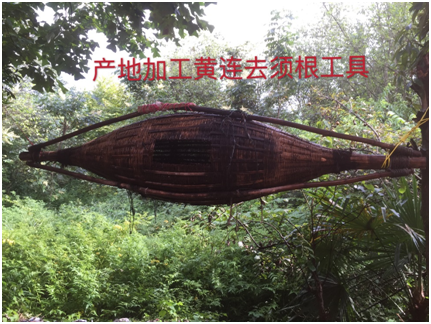
Mr. Xu Jintang, known as the “Saint of Huang Lian”, developed a method using wet sand and Huang Lian seeds to solve the physiological dormancy problem of Huang Lian seeds, successfully pioneering ecological cultivation techniques for Huang Lian in 1966, establishing the technological foundation for the original ecological cultivation of Huang Lian in Lichuan. By 2013, the Lichuan Huang Lian base received national GAP certification, becoming the first authentic medicinal material in Hubei Province to achieve certification. The GAP base has strict regulations regarding air, soil, and water, and has established production techniques for Huang Lian seeds and seedlings: land selection and preparation (land should be prepared before October, with base fertilizer applied before making beds), sowing (October-November, 2.5-3 kg per mu, covered with 0.5 cm of fine soil or well-rotted organic fertilizer), shading (setting up shade structures, using branches or small shrubs for cover, with over 80% shading), seedling management (fencing, leaf collection, weeding, thinning, and fertilizing), and transplanting (in the third spring, seedlings should have 5 leaves and be over 5 cm tall), along with management practices.
1. Huang Lian is a shade-loving plant that grows in moist environments under forests, thus it has developed a preference for weak light and aversion to strong light.Different growth ages of Huang Lian have varying shading requirements: one-year-old Huang Lian prefers 75% shading, two-year-old Huang Lian prefers 60% shading, three-year-old Huang Lian prefers 60% shading, four-year-old Huang Lian prefers 45% shading, and five-year-old Huang Lian prefers full light or slight shading. The same shading conditions have a significant impact on Huang Lian at different ages.
2. Huang Lian seeds have dormancy characteristics and require morphological and physiological maturation before germination.The best germination beds for Huang Lian seeds are soil and sand beds; paper beds are not conducive to germination. Sand beds can promote seed “cracking”. Generally, the optimal germination temperature for seeds is around 20°C, while Huang Lian seeds germinate best at around 12°C. Seed germination requires weak light, as high light is detrimental to Huang Lian seeds, likely due to their preference for shade and cool conditions. Screening results indicate that soil beds, 12°C, and low light of 600-800 Lx provide the best conditions.
3. Huang Lian seedling grading standards: Grade I seedlings: ≥8 leaves, height ≥12 cm; Grade II seedlings: ≥5 leaves, height ≥9 cm; Grade III seedlings: ≥4 leaves, height ≥6 cm. Seedlings below Grade III need to be kept for further cultivation.
4. Research on the harvesting period of Huang Lian indicates that the optimal harvesting period for Wei Lian rhizomes, based on the accumulation of berberine and total alkaloids, is October to November, which aligns with traditional harvesting practices. The best harvesting period for Lichuan and Shizhu Wei Lian is October to November, five years after transplanting, at which point the dry weight and effective component content of Wei Lian rhizomes reach their optimal economic threshold. The base conducts field research on planting techniques, applying crop rotation models and ecological planting models in GAP bases.
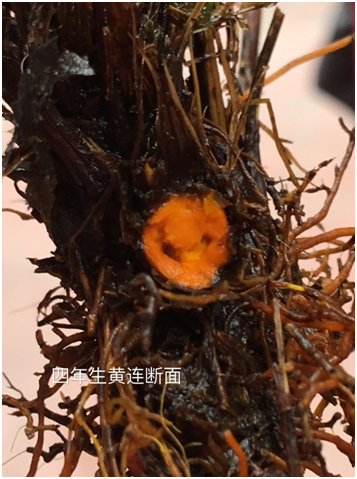
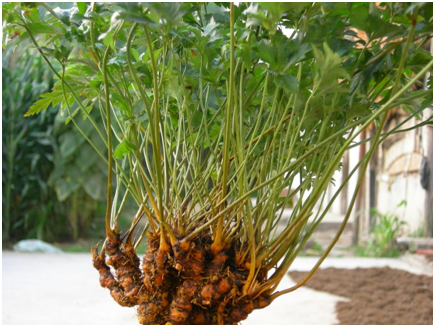
Authentic medicinal materials arise from hardship. The journey to seek Lian in Lichuan is not only an expansion of knowledge but also a spiritual cleansing. May we not forget our original intentions to achieve our goals!
Contributed by Zhangjiagang City Traditional Chinese Medicine Hospital Pharmacy Department “Cao Mu Ben Xin” Science Popularization Team
Reviewed by: Qian Wei, Deputy Chief Chinese Medicine Pharmacist
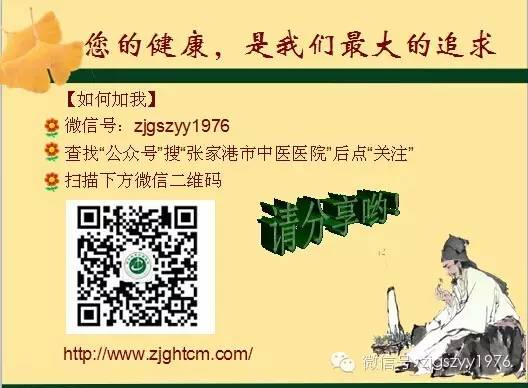
WeChat matrix of various departments in the hospital
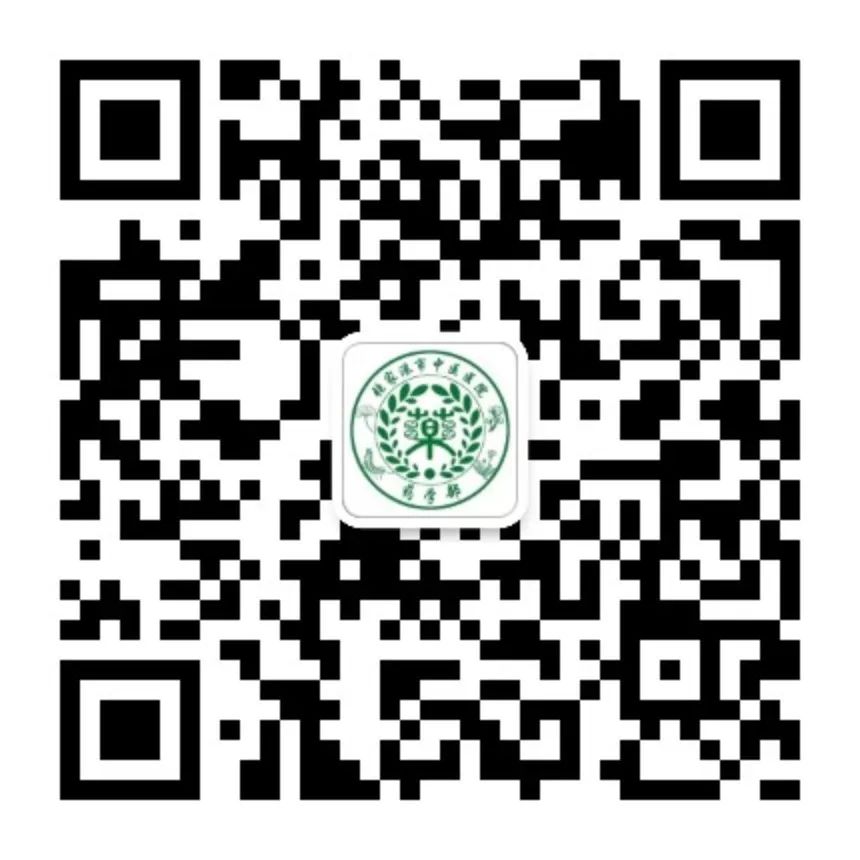

Pharmacy Department Reproductive Medicine Center


Acupuncture and Tuina Department External Medicine Department

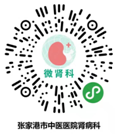
Ophthalmology Otolaryngology

Nephrology


(Some images in the text are sourced from the internet for layout aesthetics; please inform us for removal if there are any copyright issues)

